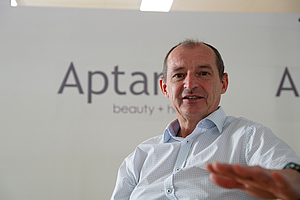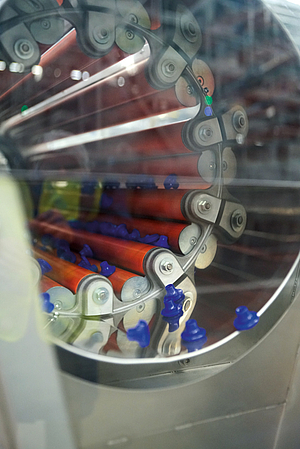

We want to know from Bruno Königseder and Augustin De Tilly from Aptar, what lies behind the development of a new product category such as “Tethered Caps”. In other words, what does it mean to develop a new era of closure?
CC: How do you handle new and upcoming challenges?
It is a process, as with all other new developments. Before we start as developers and engineers, another process is more important; another area is more important: First and foremost, it is about understanding consumer needs and consumer behavior, which today is more than ever characterized by convenience and sustainability. We as Aptar are completely open to the new challenges of the market and sustainability requirements. We started developing the topic of tethered caps for flat caps five years ago. So it is not new to us. It’s a new challenge for the entire market, not just for the closures.
CC: Flat and flip caps are not really new, they have been used for some time, for example, for home care products. The application in the beverage sector, however, is new. Are new solutions needed here?
Yes, indeed, this is a new kind of challenge. The requirements are different. Of course, beverage bottles are used differently than, for example, a home care bottle, and this has a great effect on the closure. Imagine a bottle with a flip cap: While the bottle containing detergent is mainly moved only within the household, beverage bottles lead a completely different way of life: they are used in the car, on the bike and for example during sports. The bottle may be transported in a bag along with a laptop, possibly the bottle is pressurized laterally or otherwise experiencing higher pressure, possibly taking damage. That means the locking system has to be absolutely safe - without leakage. So we start our considerations with the end user, the consumer as a starting point. Only then does our gaze focus on the technology. What the consumer wants and how he uses the packaging, that’s the question first. As a result, with regard to tethered caps for beverage bottles, we had to create something new, a snap cap with a large opening angle. That is, when the consumer drinks, the cap must be far away from the face. It must under no circumstances disturb the mouth and affect the drinking pleasure. So with a detailed consumer study, we can find and define the technical specifications for new applications or challenges. And then the development begins. We have managed to generate some patents for this new closure. There are many specific, small aspects that are very important in the end for the technical solution.

CC: How do you gain the overall picture of the new challenge?
It is a close look at the details. It is a close look at the “bottle + cap” system. The requirement was: wide opening angle with a fixing mechanism, so that it is far from the mouth and can be fixed in this position so that the consumer does not come into contact with the lid when drinking. We had to develop specific test procedures and test equipment to obtain specific data to improve the technical solution. The testing of the closure also has something to do with the bottle itself, its shape, its stiffness and so on. Cap and bottle are a system. You can feel it when you open an extremely light bottle compared to a bottle with higher wallthickness. The bottles behave differently, the opening characteristics are different.
CC: Does that make the cap development even more difficult?
In any case, we talk about different challenges, and sometimes you have to find a compromise. It is about product protection with the security tape for detecting tampering with the bottle. It’s about easy opening and safe closing, this also several times. And in addition, it’s about tethered caps. And you should not forget that these are all the technical challenges we need to solve as a manufacturer of closures. As I said earlier, the closure is part of a system, and so we also need to talk to the upstream links in the value chain: machine manufacturers for preforms and bottles, for filling technology and sealing. And in the end you have to convince the bottling companies and brand owners. Because they will ask if the new system works on their bottling lines. So we’re taking pre-qualification steps until we’re ready to put this new product on the market.
CC: Do legal requirements necessarily mean limitations?
Limitations are always a matter of demands. The tethered cap means restrictions on the short neck: From the perspective of sustainability and cost, the neck for flat caps should be kept as short as possible. To tie or bind the cap, we have to accept today: tethered closures require longer bottle necks.

CC: Isn’t it a pity?
Maybe at first glance, but we accept these challenges positively. To be honest, over the last ten to twelve years, our innovations have been driven by lightweighting, lightweighting and once again lightweighting. That was the continuous goal. Today, there are additional, new challenges and priorities. Focussing on a new priority leads to new innovative solutions. Driving innovation requires us to think outside the box to find new products and technologies that are relevant to all of us in this industry. At a certain point in time, we no longer operate our development only in a protected environment. We have to discuss our developments with partners along the value chain.
CC: Did the demand for tethered caps come as a surprise to you?
Five years ago, we began to develop our vision of future cap solutions. Since then we have been working on a new era of closure technology. Of course, when we first started the snap cap development, we were not there for the first tests where we are today - and we are not at the end of the possibilities yet. We are firmly convinced that the most efficient way of developing things is to start a development process with your own motivation and self-imposed goals rather than being forced by the law, for example. We anticipated the legal requirements with our predictive gaze, so to speak. But I admit: in the last month, we have focused even more on this development, given the legal situation. It gave us a little more speed.
CC: As a PET packaging specialist, you always take a look at the bottom of the bottle when you find an interesting product on the shelf. Is it similar for caps and closures experts like you and your colleagues? Do closures and their opening and closing behavior have a similar appeal?
Yes (laughs). And we take advantage of this reflex. We often go through the production hall with new developments and ask our colleagues: “Can you open the bottle? Is it easy? What is your impression?” So we get a very fast first feedback. And we do that, for example, in the USA or even in China. We also carry out external consumer tests and have a department that specializes in consumer reception.
CC: Is the current development of tethered caps for CO2 applications still taking place in a protected environment?
We are still working in the status of concept development and prototyping. So yes: everything is still taking place under our roof. Again, we focus on the consumer experience, but also on technical issues for the cap, bottle and filling line: the least possible use of material and a simple change from still to carbonated drinks in the filling line. As I said, developments start in sheltered surroundings.
The comPETence center provides your organisation with a dynamic, cost effective way to promote your products and services.

magazine
Find our premium articles, interviews, reports and more
in 3 issues in 2025.



